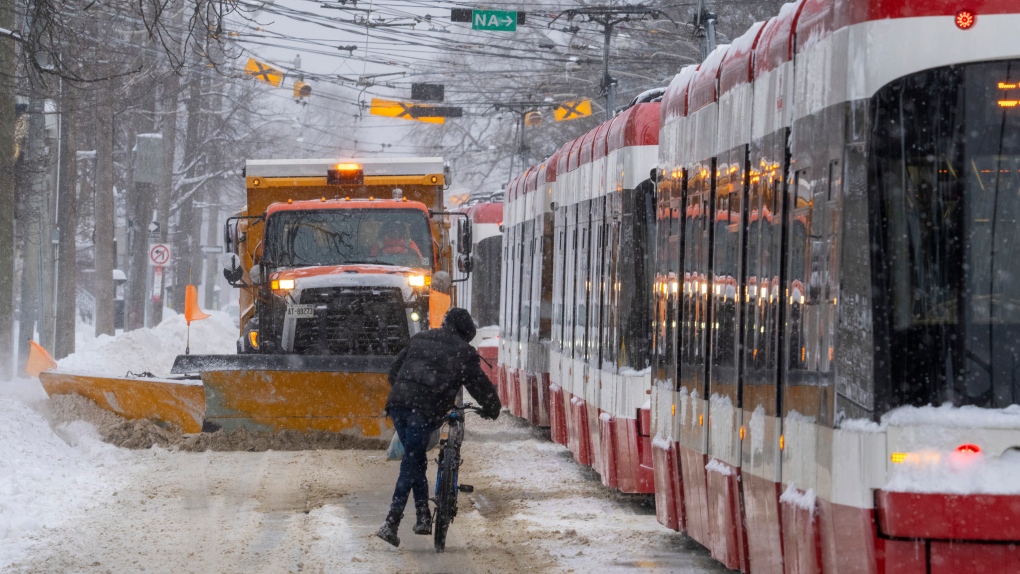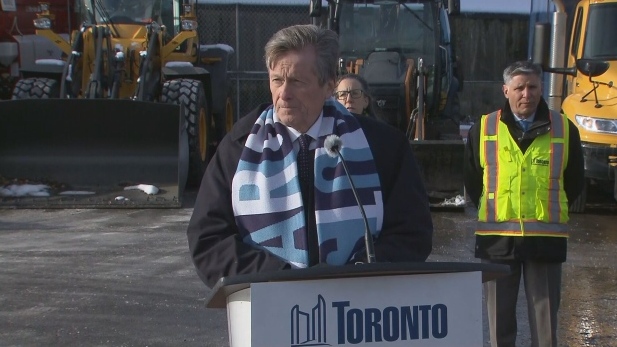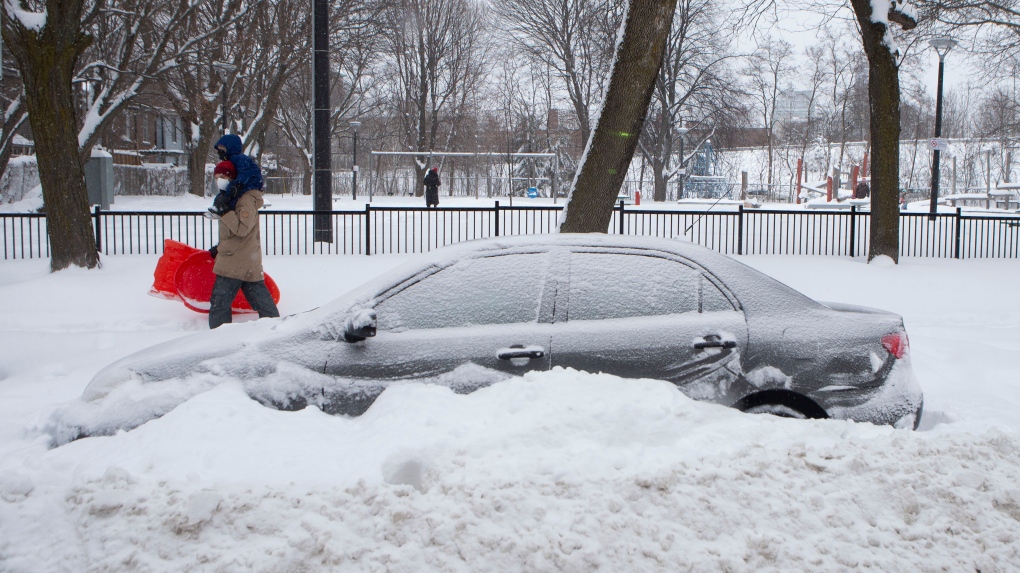'More prepared than ever': Toronto outlines $109M winter weather plan
 A cyclict hops off his bike to get out of the way of a snow plow while making his way past dozens of stranded streetcars during a severe winter storm in Toronto on Monday January 17, 2022. THE CANADIAN PRESS/Frank Gunn
A cyclict hops off his bike to get out of the way of a snow plow while making his way past dozens of stranded streetcars during a severe winter storm in Toronto on Monday January 17, 2022. THE CANADIAN PRESS/Frank Gunn
The City of Toronto will be deploying salt trucks as soon as snow starts sticking to the ground this winter season, rather than waiting for snow to accumulate in previous years.
The new move is part of the city’s winter weather readiness plan which also includes new snow response technology and replenished snow clearing equipment including salt supplies to clear roads, sidewalks, bicycle lanes and respond to watermain breaks.
- Download our app to get local alerts on your device
- Get the latest local updates right to your inbox
The city outlined the plan in a news conference Thursday morning, two days after the city’s first significant snowfall of the season.
“We put aside in the budget approximately $109.5 million in the proposed 2023 winter operations budget in order to ensure that our roads and sidewalks are clear and safe. We're tracking the weather and as we've seen this week, personnel are ready to go at a moment's notice to prepare our streets for the snow that is to come,” Mayor John Tory said at the city’s Wellington Works Yard.
The city’s winter plan prioritizes safety and mobility, particularly for residents, and emergency and transit vehicles.
The city says more than 1,500 workers are on standby and over 1,400 pieces of equipment are ready to clean up snow and ice.
Salting is the city’s first step when snow begins to fall, and then plowing begins when the snow is five centimetres deep on expressways, five centimetres deep on major roads and transit routes, and eight centimetres deep on residential streets.
Tory says the city has negotiated a new set of seven-year winter contracts this year which will provide more flexible and accountable snow clearing and salting services.
“In previous years, the city only began operations on the smaller local roads after five to eight centimeters of accumulation. But these new contracts in place this year now will see salt trucks dispatched as soon as the snow starts sticking to the ground, and that was something that happened in many areas of the city just in the last number of days,” Tory said.
 John Tory provides an update on the city's upcoming snow removal efforts on Nov. 17, 2022.
John Tory provides an update on the city's upcoming snow removal efforts on Nov. 17, 2022.
The city says crews work to salt and plow major roads and expressways within four to six hours, and salt and plow local roads within eight hours and 14 hours, respectively.
“We do ask that the residents hold off for approximately 14/16 hours by the time we deploy our vehicles. At that point they can certainly call 311 and request a service request for any issue that they may see that needs attention,” Transportation Operations and Maintenance Director Vincent Sferrazza said.
The new contracts include new GPS power to track equipment and enhanced weather predicting technology. The new deals also allow the city to start clearing public sidewalks when snow accumulation reaches two centimetres.
“Before snow reaches two centimeters, we would ask that people continue to be…good neighbors and help keep sidewalks and pathways clear for your friends and families but also for your neighbors and especially those who might have a little more of a challenge getting around,” Tory said.
 A car remains behind a snowbank in downtown Toronto as a heavy snowfall affects the greater Toronto area on Monday January 17, 2022. THE CANADIAN PRESS/Chris Young
A car remains behind a snowbank in downtown Toronto as a heavy snowfall affects the greater Toronto area on Monday January 17, 2022. THE CANADIAN PRESS/Chris Young
To track plowing efforts around the city, residents can use the city’s salt truck and snow plow tracker, PlowTO, which will be launched in December.
Toronto’s winter plan also includes details on maintaining and monitoring underground infrastructure.
Cold weather and rapid swings in temperature can cause an increase in watermain breaks.
Tory says staff are ready to respond to service calls to prevent pipes from freezing.
“Every year, the city upgrades hundreds of kilometres of watermains, some more than a century old. I know that the replacement of these antique watermains causes traffic disruption but it is work that cannot be postponed, as happened over many decades in the past,” he said.
The city has been investing $150 million annually to improve the watermain distribution system, which includes roughly 30 to 40 kilometres of watermain pipes being replaced every year and the rehabilitation of an additional 100 to 130 kilometres of water pipes.
The city’s winter plan comes after a major winter storm last January when 55 cm of snow fell on the city in a span of 15 hours. According to the city, 180,000 tonnes of snow were removed from streets, sidewalks, and bicycle paths at a cost of more than $17 million.
“The staff have assured me in this briefing that resulted from all of their work and reflection and an examination of what happened then, and generally with regard to winter snowfalls, that they are more prepared than ever for winter weather,” Tory said.
More information about the city’s salt management and snow clearing operations can be found on its website.
 A woman makes her way along a street in downtown Toronto as a heavy snowfall affects the greater Toronto area on Monday January 17, 2022. THE CANADIAN PRESS/Chris Young
A woman makes her way along a street in downtown Toronto as a heavy snowfall affects the greater Toronto area on Monday January 17, 2022. THE CANADIAN PRESS/Chris Young
CTVNews.ca Top Stories

Bird flu, measles top 2025 concerns for Canada's chief public health officer
As we enter 2025, Dr. Theresa Tam has her eye on H5N1 bird flu, an emerging virus that had its first human case in Canada this year.
Azerbaijan observes day of mourning for air crash victims as speculation mount about its cause
Azerbaijan on Thursday observed a nationwide day of mourning for the victims of the plane crash that killed 38 people and left all 29 survivors injured as speculation mounted about a possible cause of the disaster that remained unknown.
Donald Trump says he urged Wayne Gretzky to run for prime minister in Christmas visit
U.S. president-elect Donald Trump says he told Canadian hockey legend Wayne Gretzky he should run for prime minister during a Christmas visit but adds that the athlete declined interest in politics.
Thousands without power on Christmas as winds, rain continue in B.C. coastal areas
Thousands of people in British Columbia are without power on Christmas Day as ongoing rainfall and strong winds collapse power lines, disrupt travel and toss around holiday decorations.
Prayers and tears mark 20 years since the Indian Ocean tsunami that killed some 230,000 people
People gathered in prayer and visited mass graves in Indonesia’s Aceh province on Thursday to mark 20 years since the massive Indian Ocean tsunami hit the region in one of modern history’s worst natural disasters.
New York taxi driver hits 6 pedestrians, 3 taken to hospital, police say
A taxicab hit six pedestrians in midtown Manhattan on Wednesday, police said, with three people — including a 9-year-old boy — transported to hospitals for their injuries.
Historical mysteries solved by science in 2024
This year, scientists were able to pull back the curtain on mysteries surrounding figures across history, both known and unknown, to reveal more about their unique stories.
Ho! Ho! HOLY that's cold! Montreal boogie boarder in Santa suit hits St. Lawrence waters
Montreal body surfer Carlos Hebert-Plante boogie boards all year round, and donned a Santa Claus suit to hit the water on Christmas Day in -14 degree Celsius weather.
Canadian activist accuses Hong Kong of meddling, but is proud of reward for arrest
A Vancouver-based activist is accusing Hong Kong authorities of meddling in Canada’s internal affairs after police in the Chinese territory issued a warrant for his arrest.

































